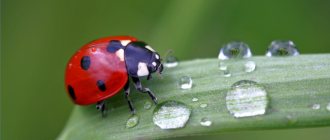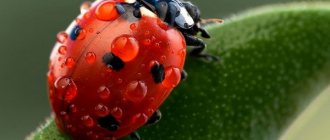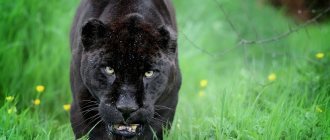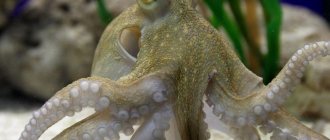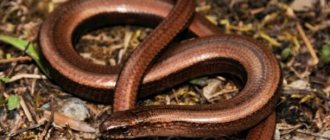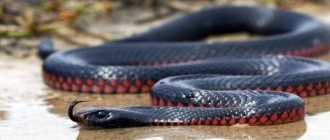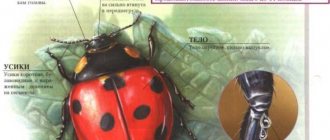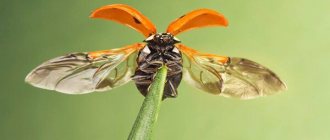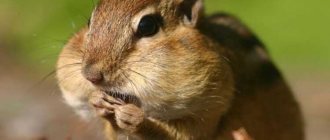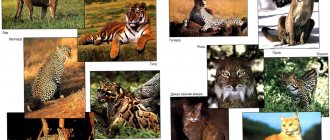The ladybug belongs to the family of beetles, has a hemispherical body and lives in almost all countries, with the exception of areas with constant sub-zero temperatures. They are generally noticeably yellow, red or orange colored insects with small black spots on the wings. The lifespan of a ladybug is several months; in rare cases, the beetle lives for more than a year; the main period of activity occurs in spring - autumn. Ladybirds can often be found indoors in late autumn, when they leave their feeding grounds in fields and forests and look for places to winter.
Ladybugs are quite voracious predators that feed on herbivorous insects; their constant food is aphids and spider mites, which makes beetles useful for agriculture, as they destroy a large number of plant pests. The cows' diet also includes psyllids, scale insects, and scale insects. In the United States, the ladybug is an excellent example of natural biological control, posing a serious threat to pests such as the European corn borer, which is estimated to cause more than $1 billion in damage to the US agricultural industry annually. Some insects, such as the Twenty-two-spot ladybird, feed on fungal spores called powdery mildew.
Not all ladybugs are equally useful - there is a twenty-eight-spotted ladybug, sometimes called the potato ladybug, which feeds on potato crops, cucumber and tomato seedlings, and other vegetable crops. There is also the pointless ladybird, a beetle that loves clover and alfalfa.
The main enemies of ladybugs are spiders and frogs, from which the ladybugs defend themselves with varying degrees of success with a sharp-smelling toxic liquid secreted from the joints of their legs. An additional way to protect themselves from hostile hungry insects that are not colorblind is the bright color of their wings, which fades with age. Birds that happily feed on various insects do not eat ladybugs and do not pose a danger to them.
Reproduction of ladybugs
Ladybugs begin to reproduce in early March, when insects mate. Female beetles lay up to three hundred elongated eggs in places with large concentrations of aphids, since the larvae hatching from the eggs immediately begin to feed on aphids, eating them in large quantities. After 10–15 days, the larva clings to the leaves of plants and turns into a pupa, in which the adult ladybug is formed within two weeks. The average time from laying eggs to the formation of an adult insect is about one and a half to two months.
Origin of the species and description
Photo: Ladybug
The ladybug is a very common ancient arthropod insect all over the world, a representative of the order Coleoptera and the ladybird family. This insect received its scientific name Coccinellidae due to its scarlet color. The bug lives almost everywhere. It was popularly nicknamed the ladybug because of the poisonous white liquid or “milk” that the insect secretes to scare away predators, and the ladybug because it helped in the fight against aphids and other pests to preserve the harvest, had a gentle disposition, and did not cause any harm to humans. .
Video: Ladybug
In Germany and Switzerland, the tiny insect is called St. Mary's bug, in South America - St. Anthony's ladybug. There were many legends about this little bug; it was said to have the ability to influence the weather.
Interesting fact: Even in ancient times, the Slavs considered the ladybug to be a heavenly creature, a messenger of the sun. That is why she was often called “Sunny”. It was forbidden to drive away the insect, so as not to incur bad luck. A bright bug that flew into a home brought blessings.
There are a huge number of varieties of ladybugs: the entire family has more than four thousand species, which in turn are divided into 7 subfamilies and 360 genera. The ladybug differs from other representatives of the family Coccinellidae in the structure of its legs. In the structure of each of them there are three visible and one hidden segment, so they seem to be three-component.
Ground beetle (Carabidae)
Ground beetles are one of the most numerous families of beetles on the planet. According to some reports, the number of species of this insect reaches 50 thousand; more than 3 thousand species live in Russia. The forest ground beetle (its other name is the garden ground beetle) is found most often in summer cottages.
Due to the wide variety of species, it is difficult to unambiguously describe the appearance of the beetle. Most often, ground beetles are dark in color; in some species, the elytra have a metallic sheen. The sizes also vary greatly: there are very tiny individuals, whose length is slightly more than 1 mm, and there are 10-centimeter giants. On average, the body length of ground beetles that live in the middle zone reaches 2-4 cm.
Despite the presence of wings, most species of ground beetles fly very poorly, and some lack this ability altogether. These beetles move with the help of their thin and rather long legs, and they do it very quickly.
Ground beetle larva
Only some species of ground beetles are phytophagous, i.e. eat plant foods. The bulk of insects are predators, both adult beetles and larvae. Due to this feature, ground beetles are used as biological protection agents for crops against pests.
Ground beetles happily eat caterpillars, slugs, snails, aphids, sawflies, as well as eggs, pupae and larvae of various insect pests. In a word, the ground beetle is one of the main assistants of the summer resident. She stands day and night (some species are more active during the day, while others are nocturnal) to protect your crop.
Ladybug: description, structure, characteristics. What does a ladybug look like?
According to the biological classification, the ladybug is an arthropod insect that belongs to the Coleoptera and the family of ladybirds.
The size of a ladybug ranges from 4 to 10 mm. The shape of their body is either round or oval-elongated, flat below and very convex above. The body surface of some types of ladybugs is covered with fine hairs. The structure of their body includes a head, a pronotum, a chest consisting of three sections, an abdomen, wings with elytra and three pairs of paws.
The ladybug's head is small (although in some species it may be slightly elongated), it is motionlessly connected to the anterior chest. But the ladybug's eyes are relatively large. The insect's antennae, which consist of 8-11 segments, are highly flexible.
The ladybug's pronotum is convex, has a transverse structure and a notch at the anterior edge. On its surface there are often “signature” spots of different shapes.
Thanks to the presence of three pairs of paws, the ladybug can move quite quickly both on the grass and along plant stems. The abdomen of ladybugs consists of five or six segments, which are covered from below by sternites (segmental semirings).
Despite the fact that ladybugs have two pairs of wings, they fly only with the help of their two hind ones. The front wings, in the process of evolution, were transformed into hard elytra, which serve as protection for the hind wings at the moment when the ladybug is on the ground.
As a means of protection against predators, ladybugs are capable of secreting a kind of poisoned “milk” - cantharidin, a toxic yellow liquid that also has an unpleasant odor. Additionally, the bright colors of the ladybug scare away enemies. The color of the ladybug's protective covers can be not only bright red, but also yellow, black, white with spots of different colors and different configurations. Sometimes the pattern on the pronotum of a cow can indicate its gender.
Order Lepidoptera or Butterflies
Order Lepidoptera (Butterflies). 130,000+ species. The mouthparts of the caterpillar are sucking, while those of the caterpillar are gnawing. 2 pairs of wings covered with scales. Representatives: swallowtail, cabbage, urticaria, peacock's eye, hawk moths, silkworms
Over 150 thousand species are known.
They have 4 wings. The wings are covered with modified hairs - microscopic scales. The variety of patterns and colors of the wings depend on the color, structure, placement of scales, and their ability to refract light. They can amaze with their beauty (Apollo, swallowtail, etc.). On the head are large compound eyes and a pair of antennae. The segments of the thoracic region are fixedly connected to each other. The thoracic legs are thin, weak, but tenacious.
The oral apparatus is sucking, has the appearance of a long proboscis, and is bent spirally at rest. Butterflies lay eggs mainly where the larva will feed (on branches, leaves, tree bark, etc.). The larva of butterflies - a caterpillar - has a gnawing mouthparts, 3 pairs of thoracic and 5 pairs of false abdominal limbs with claws at the end. The caterpillar has developed silk glands, in addition to salivary glands. They weave a cocoon from silk threads, where they pupate, descend from tree branches, and entwine leaves and shoots. Caterpillars of some species can form common web nests (apple moth, goldentail, etc.).
Adult butterflies are plant pollinators. The larvae of many species are pests of cultivated plants (cabbage moth, apple moth, ringed silkworm, etc.). House moth larvae damage fur, woolen items, etc.
Man breeds mulberry, or mulberry, and oak silkworms to obtain silk.
Representatives: swallowtail, cabbage, silkworm , etc.
Butterfly development. Silkworm and swallowtail.
Cabbage (Pieris brassicae)
The wings are white with small black spots. Daytime butterflies. Agricultural pests. Females lay eggs (15–200 pieces) on the underside of cabbage leaves. The caterpillar damages cabbage and other cruciferous plants. Has a greenish color. There are yellow stripes and black spots along the sides and back. A mature caterpillar crawls onto trees, walls, fences, etc. and turns into a pupa. The young butterfly waits for some time until its wings straighten and become stronger. During the growing season, 2–4 generations develop.
Mulberry or mulberry, silkworm (Bombyx mori)
Known to mankind for over 4 thousand years. Completely domesticated species. It is bred in artificial conditions, since it cannot exist in nature. It was bred by the Chinese and brought to Europe by the Arabs. Now there are different breeds of silkworms, which differ in the amount of silk in the cocoon and its quality.
Silkworms have wings, but they have lost the ability to fly. Adult insects do not feed. Females have feathery antennae and a thin abdomen. They lay a large number of eggs (400–700) - eggs , after which they die.
A caterpillar is hatched from eggs under special conditions. They are fed mainly on mulberry leaves (for which the insects got their name). The caterpillar is inactive and has a whitish color. At the end of the abdomen there is a horn-like appendage. They develop in 26–40 days and molt four times. After this, they weave a cocoon, in the middle of which they turn into a pupa. The thread in the cocoon reaches approximately 1000 m. A certain part is left for breeding, others are killed with hot steam or another method and dried. Cocoons are unwound on special machines. Raw silk is obtained from cocoons.
What does a ladybug eat?
Photo: Miraculous ladybug
The ladybug is a real predator among insects. Thanks to the structure of its jaw and the functioning of its digestive tract, it is able to hunt other insects and then quickly digest them. There are varieties that choose plant food: pollen, mold, flowers and leaves.
The diet of predatory species includes mainly:
- aphids in huge quantities;
- spider mites;
- caterpillars;
- insect larvae;
- butterfly eggs;
- some do not even disdain the larvae of Colorado beetles.
Ladybugs eat a lot, they are always hungry, especially their larvae. Each individual can easily destroy more than a hundred aphid larvae per day. Having large eyes, insects mainly use only their acute sense of smell in search of food.
The bugs do not hunt their victims, but only slowly, leisurely move through the foliage in search of food, and when they find a colony of aphids or a clutch of eggs of pests, they linger for a long time in this place for a meal until they destroy it completely. That is why the ladybug is a welcome guest on any personal plot, agricultural fields with crops, and in the garden. They are even specially bred at special enterprises and then distributed over cultivated lands with the help of agricultural aviation. Unfortunately, some varieties of these bugs, mainly living in Asia, cause damage to crops.
Now you know what ladybugs eat. Let's see how to breed these beautiful insects.
Order Diptera (Diptera)
Order Diptera. 8,500+ species. The mouthparts are piercing-sucking or gnawing-licking. 1 pair of membranous wings, hind wings modified into halteres. Representatives: flies, mosquitoes, gadflies, horseflies, etc.
Over 80 thousand species are known, in our country - over 4.5 thousand. They have a developed one pair of membranous wings. The second pair of wings is transformed into two small club-shaped appendages - halteres, which play the role of an organ of balance. The chest is large and consists of three fused segments. They have a very mobile head. The mouthparts are sucking-licking or piercing-sucking. Sometimes adult insects do not feed (for example, gadflies). Diptera larvae have no legs, and fly larvae have almost no head.
They are divided into long-whiskered or mosquitoes and short-whiskered or flies . Long-whiskered antennae are elongated and multi-segmented. In short-whiskered animals, the antennae are shortened and three-segmented. The long-whiskered ones include mosquitoes, midges, mosquitoes, etc. The short-whiskered ones include flies, gadflies, etc.
Long-whiskered Diptera
Mosquitoes
Development of a mosquito: eggs – larva in water – pupa – adult insect (imago)
Mosquitoes have a slender body and a piercing-sucking mouthpart. Found everywhere. They are capable of storing about 50 viruses in the body and transmitting them to animals and humans. Only females feed on blood; males feed on nectar and plant juices. After fertilization, females look for hosts to drink blood. This is necessary for the maturation of eggs in the insect’s body. Eggs are laid in water or moist soil. Larvae and pupae develop in water and breathe air. Pupae are mobile.
Malaria mosquitoes (genus Anopheles) are carriers of the malaria pathogen, Plasmodium falciparum. Malaria mosquitoes have a number of differences from the common non-malaria mosquitoes of the Culex genus:
| Malaria mosquito | Culex mosquitoes |
| Eggs are scattered on the surface of the water | Eggs are laid on the surface in a heap or boats |
| Each egg has a belt, air chambers | They do not have a belt or cameras |
| They do not have a breathing siphon, there is only one pair of breathing holes on the penultimate segment, located horizontally to the surface of the water | The larvae have a respiratory siphon, so they are located in the water at an angle |
| Adult insects hold their abdomen at an angle to the surface on which they sit | Adult insects hold their abdomen parallel to the surface on which they sit |
Adult mosquitoes also differ in the structure of their head appendages and the color of their wings.
Midges (Simulium)
Midges are small in size. Their larvae develop in bodies of water with currents. Some species of these insects can be carriers of dangerous animal diseases.
Mosquitoes (Phlebotomus)
Mosquitoes look like small gnats with colored wings. The body and wings are very pubescent. Their larvae develop in damp places: fallen leaves, soil, rodent burrows, etc. They feed on rodent excrement and organic matter. Mosquito bites are very itchy, pain and itching persist for a long time, and a fever-like condition may appear. Mosquitoes are carriers of cutaneous and visceral leishmaniasis.
Short-whiskered Diptera
flies
Development of a fly: eggs – larva – pupa – adult insect (imago)
Flies ( house flies, green flies, blue flies, etc.) have worm-like larvae. Adult insects feed on various foods, including human foods (they apply a drop of saliva to the food and then lick it off). Fly larvae develop on garbage bins, in corpses, and in animal and human excrement. Flies spread pathogens of many diseases (dysentery, tuberculosis, typhoid fever, etc.).
Botfly bites are very painful. These insects are capable of transmitting diseases such as tularemia and anthrax.
House fly (Musca domestica)
The house fly has a grayish-brown color. There are four dark longitudinal stripes on the chest. Body dimensions - 6-8 mm. Distributed everywhere.
On the head there are large compound eyes, a pair of short antennae (olfactory organs). On the paws between the claws there are adhesive pads covered with hairs, which allow the insect to move along vertical surfaces, and even upside down. The paws have taste organs.
They feed on liquid food. The fly's mouthparts are a soft sucking-licking proboscis that is formed from the lower lip. She sits on food and secretes a drop of digestive juices on them, which dissolve the food. Then the fly licks up this liquid.
The eggs of the fly are laid (up to 160 at a time) in food scraps, feces, corpses, rotting remains, etc. Under favorable conditions, the larva emerges through a pore. It is worm-like, has no limbs, and almost no head. Pupates after 1–2 weeks in soil or substrate where organic matter and larvae are located. The adult insect emerges after another 1–2 weeks.
Various dirt, as well as pathogenic bacteria, cling to the hairs of the housefly's limbs. Over 6 million bacteria were counted on the body of one fly, and up to 28 million in the intestines. The species composition of bacteria carried by flies is diverse (up to 40 species). The feeding habits of flies also contribute to the spread of pathogenic bacteria. They spread pathogens: typhoid fever, dysentery, cholera, diphtheria, anthrax, etc. They can spread protozoan cysts and helminth eggs.
Gadflies
Gadflies are classified as short-winged dipterans. Adult insects do not feed. They live off the substances accumulated during the larval period. The larvae parasitize the body of animals.
There are several types of gadflies: subcutaneous, gastric, nasopharyngeal .
Females of the subcutaneous gadfly lay eggs on the fur of the hind legs of animals (cattle). The larvae burrow through the skin into the tissue and migrate throughout the body. They complete development under the skin on the back. The mature larva gnaws through the skin and falls into the ground, where it pupates. Holes remain in the skin of animals.
In the gastric gadfly, the female lays eggs on the horses' fur. The larva hatches and begins to burrow into the skin, causing itching. Animals accidentally lick the larvae and swallow them. The larvae enter the stomach, feed there and mature. Ripe (after 10 months) larvae fall with feces to the ground and pupate there.
Female nasopharyngeal botflies are viviparous and inject liquid with larvae into the nostrils or eyes of animals (horses, sheep). The larvae develop in the nasopharynx, pharynx, and frontal sinuses.
Lifestyle
Ladybugs prefer to live “alone”, apart from other representatives of the species.
Only during the mating season do they come together to continue their family line. They also gather together for flights and wintering.
A ladybug can be called a fruit-loving bug, therefore, with the onset of a cold period, all insects living in temperate latitudes gather together and fly away to warm countries.
Among insects there is a sedentary species. They do not fly to countries with hot and dry climates, but gather in one place and winter in huge communities, reaching 400 million adult individuals. If you calculate how much such a “ball” weighs, you can get a figure equal to several tons.
To shelter from unfavorable climatic conditions, the “suns” hide in the ruins of stones and also take cover under fallen leaf blades of shrubs.
Under good conditions and the availability of food, spotted insects can live for 1 year. Under unfavorable conditions, the lifespan of insects does not exceed several months.
Fire beetle (Cantharidae)
Another red-and-black helper at the dacha is the firefighter beetle from the Myagkotelki family (these beetles are often called soft-bodied beetles).
Adults are diurnal. They can be seen on plants, where they sit and wait for prey. Firefighter beetles happily eat flies, small caterpillars, aphids, scale insects, and destroy insect eggs. If it happens that the number of beetles exceeds the amount of food, firefighters can change the diet and switch to plant food - buds and ovaries. However, this happens extremely rarely.
Fire beetle larva
Soft-bodied larvae, like adults, are also predators. However, they lead a more secretive lifestyle: they live in fallen leaves, the top layer of soil, under the bark of trees, under stones. Fire beetle larvae feed on worms, slugs, centipedes, larvae and eggs of other insects.
Types of ladybugs, photos and names
Zoologists identify 4,000 different species of ladybugs, divided into 7 subfamilies. We will describe the most interesting among them.
Two-spot ladybird
This is a beetle with a body length of up to 5 mm, with a dark red body and two black dots (hence the name).
Seven-spotted ladybird
It is this type of ladybug that is most common in Europe. Its size is 7-8 mm. Its elytra are painted red, there are three black spots on the sides, and the seventh is located near the head of the insect.
Twelve-spotted ladybug
This ladybug has a length of 6 mm, a bright pink or red color, and, accordingly, 12 black spots on the elytra.
Thirteen-spotted ladybird
This type of ladybug has as many as 13 spots against the background of red-brown elytra; some of its spots can merge with each other.
Asian ladybug
This ladybird is up to 7 mm long and is divided into two subspecies. One of them has a yellow wing cover with black spots, both large and small. The second subspecies is characterized by black coloration of the elytra, on which red-orange spots are visible.
Ocellated ladybird
This is a very large representative of the ladybird family, reaching up to 10 mm in length. It has red or yellow elytra and black spots surrounded by lighter rims.
Pointless ladybug
This is a very rare species; its characteristic feature is the absence of signature spots. Also, the red or brown body of the pointless ladybug is covered with small fibers.
Blue ladybug
This is another unusual member of the ladybug family, having a characteristic blue color. Such insects live exclusively in Australia.
Social structure and reproduction
Photo: Ladybugs
All ladybugs are solitary. Only during the mating season do males use a specific smell to look for a female to mate with. This usually happens in early spring and soon the female lays up to 400 eggs on the lower surface of the leaves. They are oval in shape and can be yellow or orange. The female chooses a place for laying closer to the aphid colony so that the offspring are provided with food. This is the only manifestation of caring for their offspring. Most often, she dies after this.
After a couple of weeks, the larvae appear. Their body is covered with hairs and has a variegated color; the pattern combines yellow and brown spots. In the first days, the larvae eat the remaining egg shells and unfertilized eggs, then go in search of aphids. The stage lasts from 4 to 7 weeks, after which the formation of a pupa occurs, which then attaches to the edge of the leaflet, where its further transformation occurs.
At the end of it, after 8-10 days, the skin peels off from the pupa like a stocking to the end of the abdomen. A full-fledged individual ladybug appears, which gradually acquires its usual bright color. At first, its elytra are pale in color; by this feature one can easily distinguish an adult from a young one. Young bugs are ready to reproduce at 3 months of life, some only at six months - it all depends on the quality of nutrition and environmental conditions.
Features of the development cycle
Ladybugs reproduce in spring or autumn. Depending on what species the female belongs to, she can lay from 3 to 250-300 eggs at a time. As a rule, insects do this near the aphid colony. Larval development usually occurs within 4-7 days. At the same time, every day she feeds on aphids. By the end of the second week, the larva fully matures and transforms into a pupa. The cocoon is usually located in an open place.
The transformation of the pupa into an adult occurs after 4-7 weeks. In the absence of the main type of food (aphids), seven-spotted ladybugs often move to the beaches. During such forced migration, insects are very hungry, so they can annoy even people with their weak bites.
Natural enemies of ladybugs
Photo: Ladybug in flight
The ladybug in the wild does not have many enemies due to the specific poisonous white secretion that it secretes. If a bird even once tastes a brightly colored bug, its bitter taste will discourage it from hunting for it for the rest of its life. Many insects quickly die from the ladybug's hemolymph.
The main enemy of ladybugs is dinocampus, a small winged insect that kills adult ladybugs and even its larvae by laying its eggs inside their bodies. As they develop, they feed on the body of their victim, and then the empty shell simply bursts, like in some famous horror films. Dinocampus finds bugs by their protective smell, with which they successfully scare away their other enemies. Parasites are capable of significantly reducing the number of ladybugs in a short period of time.
The active use of various chemicals for cultivating fields and the general depressing state of the environment also have a strong influence on the reduction in the population of these bright bugs. In some countries, there is a trend of replacing chemicals with natural, environmentally friendly methods of pest control. Ladybugs are bred in huge quantities and are even a national export item.
Order Fleas (Aphaniptera)
Flea Squad. 2000+ species. The mouthparts are piercing-sucking, they feed on blood, they carry plague, they have no wings, and their limbs are jumping. Representatives: human flea, cat flea, rat flea, etc.
They have a body that is flattened on the sides. Lost their wings. Nonspecific ectoparasites of animals (rodents, dogs, cats and other mammals), that is, they can pass from the host of one species to another.
The legs are of the hock type. They jump from one animal to another. They feed on blood. They can suck blood from humans. The larvae are worm-like and develop in damp, warm places (even in human habitation). They feed on organic debris. They pupate in 3-4 weeks. A young insect emerges from the pupa and waits for an animal or person to pass by. Flea bites are very itchy.
The rat flea is a carrier of plague. Plague bacteria live in the flea's intestines, multiply, and clog it. When a flea feeds on blood, plague bacteria interfere. Then the insect regurgitates them into wounds on the human body. Infection through flea feces is possible.
Representatives: human flea, rat flea , etc.
Population and species status
Photo: Ladybug
The population of ladybugs has decreased significantly due to active control of aphids. These little bugs simply have nothing to eat. Due to rapid reproduction and a small number of natural enemies, the population is able to recover in a short period of time if food is available. The status of the species is currently stable. At this time, only some rare varieties of these beetles are under threat of complete extinction, for example, the Australian blue and pointless ones.
Interesting fact: In search of food, a hungry ladybird larva can travel up to 12 meters, which is a huge distance for insects.
Trying to restore the population of beneficial bugs artificially, people sometimes, even with their good intentions, on the contrary, cause significant damage to it. In recent years, millions of individuals, specially bred ladybugs, have been released into their natural habitat, which, due to obvious mutations, changed the nature of their feeding and chose their own relatives as victims. All this caused the death of a huge number of beneficial bugs in all European countries. A thoughtful approach to this problem is needed without undue interference in the natural course of processes in nature.
Stethorus
Stetorus is the closest “relative” of the ladybug: both beetles belong to the same family. However, in appearance they bear little resemblance.
Stetorus is a small bug (its maximum length is only 1.6 mm) and black. However, despite its tiny size, it copes with the destruction of pests “excellently”. Stetorus uses spider mites as food. During its existence, the bug eats at least 2000 ticks. For this reason, Stetorus is also called the tick ladybird.
Stetorus larva. Photo from scontent.ces.ncsu.edu
Before using chemicals to control spider mites, carefully inspect the plant. Perhaps tiny stetorus beetles are already operating there and they will cope with ticks without any “chemistry”.
Ladybug protection
Photo: Ladybug from the Red Book
The ladybug has long been listed in the Red Book of many countries, including Russia. Its complete disappearance threatens to disrupt the balance in nature and actively multiply pests, which will then have to be destroyed with chemicals, and this in turn will further destroy the balance - a vicious circle is obtained.
Interesting fact: Until the forties of the 19th century, in many European countries and the United States of America, special workers tracked the wintering sites of ladybugs every fall and collected the insects in bags in winter, and then released them into gardens and fields in the spring. This environmentally friendly method of exterminating insect pests has been replaced by the active use of chemical means of killing aphids.
It is likely that in the near future people will completely abandon the use of chemicals and turn for help to ladybugs, which from time immemorial have lived next to people and helped them in the struggle for the harvest. It is not for nothing that since ancient times people have praised and worshiped this tiny bug.
Nowadays, the ladybug is successfully bred under artificial conditions. Then they are sent to the fields, but, according to many experts, it is enough just to create favorable conditions for these bugs and their population will recover on its own without human help and will remain at the level required by nature. It is necessary to maintain a balance, and for this, first of all, you should abandon the use of chemicals to treat crops against aphids, and also direct your efforts to reduce the overall level of environmental pollution.
Order Hymenoptera (Hymenoptera)
Order Hymenoptera. 90,000+ species. The mouthparts are gnawing or gnawing-licking. 2 pairs of transparent membranous wings, the hind ones are shorter, linked by hooks. Representatives: bees, wasps, bumblebees, ants, sawflies, riders, etc.
About 100 thousand species are known. Of these, 10 thousand species are found in our country. They fly well, therefore they have the most highly differentiated pectoral muscles.
Based on the nature of the connection between the abdomen and the thorax, they are divided into two suborders: sessile-bellied and stalked-bellied. In the former, the abdomen is connected to the thoracic segments by a wide base. In the latter, the second abdominal segment is elongated. The first include horntails, etc. A larger number of representatives belong to the second suborder: ants, wasps , etc.
They have two pairs of transparent membranous wings with few veins. Ants only have wings for a certain period of time. The second pair of wings is smaller than the first. Next to the well-developed pair of compound eyes there are simple ocelli. Females have an ovipositor at the end of the abdomen, which in higher forms is transformed into a sting for injecting poison. Bees use the sting for protection, and wasps also use it to obtain food for the larvae. Different in type of nutrition (herbivorous, carnivorous, polyphagous, etc.). The mouthparts are different, most often gnawing or gnawing-sucking. The larvae are worm-like. They mostly lack eyes and legs, and their heads are poorly developed. Characterized by concern for offspring.
Some species are social insects (ants, bees, wasps).
Many species of bumblebees, some bees, and ants are listed in the Red Book.
Includes bees, wasps, bumblebees, ants , etc.
Honey bee (Apis mellifera)
Bees are social insects. The structure of a bee and the development of a bee in a honeycomb
A domesticated insect, several breeds have been bred. They live in families that number 40–70 thousand bees. In nature, they settle in tree hollows. A person breeds bees in special structures - hives. The modern frame collapsible hive was developed in the 18th century by the Ukrainian beekeeper P. I. Prokopovich.
Bees have a well-developed brain (supraglottic node) and mushroom-shaped, or stalked, bodies, which determines the complex behavior of insects. In addition to compound eyes, there are three simple ocelli.
The honey bee has well-developed reproductive organs and an ovipositor. The queen bee is larger than the worker bees. Lays 300 – 1000 eggs daily. Male bees, or drones, are thicker and larger than worker bees. Both the queen and the drones do not have wax glands.
Each family has one female - the queen, or queen, several males - drones, and thousands and tens of thousands of worker bees. Worker bees are underdeveloped females that are unable to reproduce. Their ovipositor is transformed into a sting (defense organ). The sting consists of three needles, between which there is a channel for removing poison.
The gnawing mouthparts are modified; when eating food, they form a proboscis through which nectar is absorbed through the pharynx. Nectar is collected in the enlarged crop. There it turns into honey. The bee regurgitates it into the cells of the honeycomb. Pollen sticks to the numerous hairs found on the head and chest. An insect clears pollen. It accumulates in the form of a lump in special depressions on the hind legs. Pollen is dropped into the cells of the honeycomb and filled with honey. In this case, beebread , which is fed to the larvae.
Wax glands look like light spots - mirrors . They are located on the last four segments of the abdomen. The wax comes out through the pores and hardens in the form of triangular plates. Bees begin to secrete wax on the 3rd – 5th day, on the 12th – 28th day they reach maximum activity, and then their activity fades and the glands degenerate. The upper jaws are used for construction work. With its jaws, the bee chews the wax plates and builds cells from them.
Worker bees begin collecting nectar and pollen in the spring. The queen lays one egg (fertilized or unfertilized) in each cell. The larva hatches after 3 days; for 5 days the worker bees feed them with a special “milk” - a substance rich in proteins and lipids, which is secreted by the maxillary glands, and then with beebread. After a week, the larva weaves a cocoon. A young worker bee emerges from the pupa after 11–12 days. First, she does work inside the hive: feeds the larvae, cleans the hive, cells, and builds them. After a certain time, the young bee begins to fly out for nectar and pollen ( bribe ).
Drones hatch from unfertilized eggs. Such eggs are laid in large cell chambers. They develop longer than the eggs from which worker bees hatch.
The queen lays fertilized eggs in the queen cells, from which the queens hatch. They are fed "royal jelly" all the time. The old queen tries to destroy the queen cell, but it is guarded by worker bees. The old queen with some of the worker bees leaves the hive - swarming occurs. The worker bees curl up around the queen. It is necessary to promptly transfer the swarm to a new hive. If the swarm is not relocated, it will find a place on its own and may go wild. The queen lives from 4 to 5 years.
The young queen leaves the hive with the drones for a while, and returns after fertilization. After this, the queen returns to the hive and stores the sperm in the seminal receptacle. Drones are not allowed near the hive. They are killed by worker bees or die. Fertilization itself occurs before the queen lays eggs. When eggs are laid in drone cells, the openings of the spermatic receptacle are compressed, and the eggs remain unfertilized.
In the second half of summer, the preparation of honey reserves for the winter begins. When it gets cold, the bees seal the cracks of the hive with wax and are ready for the winter. In winter they feed on honey.
Bees are able to use a kind of dance to inform others about the location of bribes.
They are of great importance as plant pollinators, provide a valuable food product - honey, as well as substances that are used as medicine (royal jelly ( apilak ) - a bioactive and hormonal drug; propolis - bee varnish, an ancient bactericidal agent; bee venom ). Honey is nectar that is chemically changed by enzymes in the glands of worker bees. Wax is used in industry for the manufacture of medicines, perfumes, varnishes, and paints.
Ants
Ants are social insects
Collective insects. Families consist of females (one or more), males and worker ants. Worker ants can perform different functions. Along with working individuals, soldiers are also found. They have structural features: a large head with well-developed strong jaws (they serve as both a weapon and a working tool). Worker ants look after the pupae and larvae, feed them, bring prey, build the anthill, keep it clean, etc. Soldier ants protect the anthill from attacks and can themselves attack ants of other species.
The ant's head is movable. The mouthparts are gnawing. They feed on animal and plant foods. Many species destroy large numbers of harmful insect larvae. The head has well-developed compound eyes and a pair of rather long geniculate antennae. Males and females at a certain period have membranous wings that break off easily. Worker ants do not have wings. They have a movable, narrowed abdomen between the first and second segments. Some species have a sting at the end of the abdomen, through which they spray a secretion with the smell of formic acid. Worker ants are underdeveloped females that are unable to reproduce.
Able to maintain a constant temperature in an anthill. They overwinter underground, where they all gather together and maintain a certain temperature.
Some types of ants build large dome-shaped anthills ( red wood ant ), some spread aphids as they feed on their sweet secretions ( black garden ant ), some breed mold fungi underground, which they feed the larvae. The uterus is constantly licked by ants. They pass on its secretions to others. Many species of ants have joint digestion: the scout ant finds food, eats it and partially digests it, and then regurgitates it to other insects of the colony, who pass it on. the pharaoh ant, damages food products in human housing .
In forests, anthills must be protected.
Riders
These are small insects predominantly with a stalk-like abdomen. There are long antennae on the head. Females have a well-developed ovipositor. Females lay their eggs in the eggs, larvae or pupae of other insects (for which they are called ichneumon ichneumon). The larvae feed on the tissues and hemolymph of the host. They don't have legs. The victim remains alive until the ichneumon ichneumon larva matures. To form a pupa, the larva breaks through the host's integument and crawls out. The victim dies.
Some species of ichneumon ichneumon infect only certain species, while others affect different species. There are species that infect ticks that carry pathogens. Various types of parasites are used in the biological method of controlling pests of cultivated plants. They are bred in laboratories and released into pest breeding areas. Trichogramma can destroy a significant number of pest eggs in one clutch, as it lays one in each.
The benefits and harms of ladybugs
The benefits of the ladybug, especially in our latitudes, are undeniable; the principle “the enemy of my enemy is my friend” works here. Ladybugs, by eating various insect pests, provide a great service to agricultural lands. Sometimes they are even specially bred in special places and then sprayed over fields and plantations infested with pests.
But among them there are also herbivorous species, most of them live in tropical areas, which can also harm agricultural crops.
Lifestyle and habitat
Ladybugs live in almost every corner of the globe with the exception of Antarctica and the polar regions, where the air temperature never rises above zero. The habitat depends on the type of insect. It can be:
- any plants that have aphid colonies;
- meadows (most often located near water bodies);
- trees;
- field herbs;
- reed, sedge and other aquatic plants.
You can find bright bugs in a vegetable garden or garden, in a city park, on the edge of a forest.
Ladybugs are loners. They gather in groups only during the mating season, as well as for wintering or migrating to a warmer region. Insects are diurnal. They are in search of food, either crawling from plant to plant or making short flights.
Interesting facts about ladybugs
- Since ancient times, people have revered ladybugs, which in the imagination of the ancients served as the personification of divine powers. For example, our ancestors, the ancient Slavs, considered ladybugs to be messengers of the Sun goddess.
- Also, since ancient times, people used ladybugs to predict the weather, so an insect flying away from the palm promised clear and sunny weather. And vice versa, a cow that wanted to stay on the hand was a harbinger of bad weather and rain.
- In many cultures, the ladybug is considered a symbol of good luck; for the same reason, many superstitions and signs are associated with them; the common belief is that in no case should you harm these insects, so as not to incur troubles and hardships.
- It is still a mystery to scientists how ladybugs always invariably return to the same places after their migrations for the winter.
How and where do they winter?
Depending on the species, ladybugs overwinter in different ways. Sedentary species, adapted to existence in temperate climates, most often wait out the cold season, gathering in huge groups (up to several million individuals) and taking refuge under fallen leaves, under the bark of trees, between stones, hiding in buildings, such as barns, garages or even residential buildings. They fall into a state of torpor and emerge from cover only with the arrival of warmth.
Other species also unite in large colonies in the fall. But they do not stay for the winter, but fly south, where they spend the winter. Insects fly at high altitudes, descending to the ground during strong winds or rain. During such flights, many bugs die.
The colony
Interestingly, ladybugs always return exactly to the area from which they flew.

